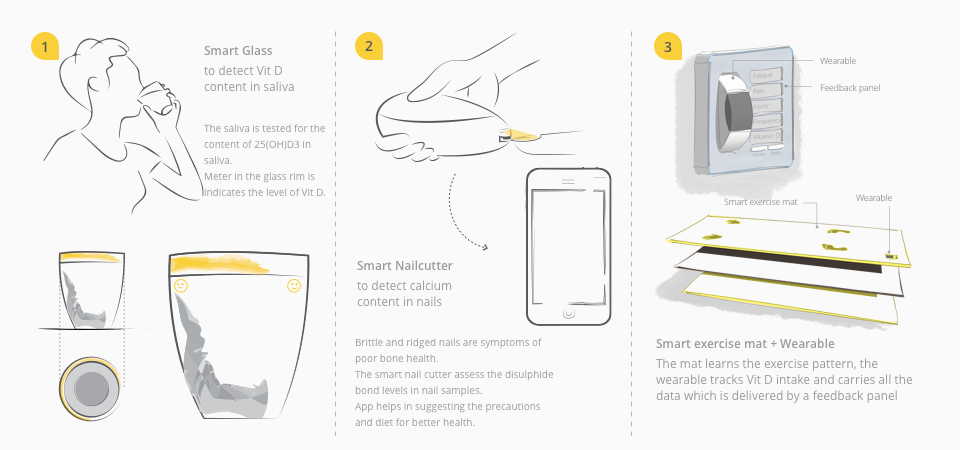Overview
Osteocare is a wearable that takes care of a woman’s bone health by keeping a track of her daily Vitamin D intake.
Bone densities of healthy and affected bones.
A woman works hard enough and takes good care of her work and her family but sometimes forgets to keep a track of her health and falls prey to some of the common health issues. Osteoporosis is a consequence of age, it grows silently and makes bones porous, brittle and hence weak, it cannot be cured by any treatment. The main cause of this disease is lack of Vitamin D and Calcium in body which usually occurs in old age and especially in women after menopause as secretion of estrogen starts decreasing. Three out of five women falls prey to this disease and it is detected mostly after getting a fracture.
Osteocare aims to motivate women to take care of their bone health and prevent osteoporosis in a healthy way, and also involving the family who can take good care of her in cases of usual negligence.
Role & Process
The project was taken up as my academic design project and it took eight weeks to come up with the solution. The brief was to develop product/ solution for “Sports and Fitness”, “Health and Wellness”, “Lifestyle needs and wants”, Safety” or "Immersive experiences for retail sector". I followed a user entered design process here.
01 Research
Firstly, I tried understanding the domain as per my eager to explore the health and wellness sector especially for women. As per the insights I chose to work for osteoporosis and began understanding it through secondary research. This helped me in getting a clear picture of the causes, risk factors and symptoms, also the treatments and safety measures. I studied the lifestyle of the women in urban and rural sectors in context of osteoporosis, in order to find the potential stakeholders.






Key findings
There after I conducted Primary Research in order to understand the awareness of osteoporosis amongst the common people and how do they take care of their health and diet. The research included interviews with 15 women above the age of 40. Following are the research findings:
01.2 Case study
Doing case study helped me understand the usual behaviour and lifestyle before and after fracture stages of a person suffering from osteoporosis.
Insights
02 Experience strategy
02.1 Ecosystem mapping
There after mapping the whole ecosystem helped me in deriving insights such as who can be the potential stakeholders, what can be the possible scenarios where Osteocare can be really effective.
02.2 Defining user-types through personas
To be really effective and to make its space in market, Osteocare needed to target the potential users first. So, defining personas clarified the challenges faced by stakeholders and their actual goals, their goals and experiences are are based on my observations from the user interviews.


02.3 Finding common ground (Value proposition)
Mapping the Osteocare business goals and the user goals to see where they align, in order to outline a valuable and best experience.
02.4 Design considerations
After understanding the responsibilities and key goals of the target audience I kept the following considerations in mind while coming up with a solution.
- The design should bring behavioural changes.
- Suggest actions without overwhelming with data.
- Should be a part of daily activities and daily use objects.
- Connect the caring ones.
- Keep a track of bone health.
- Connect with doctor or nutritionist.
02.5 Key features
For outlining the distinctive features of Osteocare, I analysed the features of the other osteoporosis prevention products in market and mapped them.
Design
I came up with the possible solutions for bone healthcare, which can track user's daily Vitamin D intake and prompt the user to take care of her health. Here are a few conceptual ideas:
The idea of having a wearable was most suitable, from the business point of view as well as from the health tracking perspective. So, keeping this in mind I did storyboarding with all the possible scenarios to explain the initial concept.
03 Interaction design
03.1 Task flow
In order to structure the content delivered to the user, I first tried understanding the priorities of the users and what they expect to see in form of feedback given by the wearable. Hence I tried sketching out a task flow for different scenarios after the storyboard above.
03.2 Validation
Mock testing the lo- fi prototype of the product revealed areas that needed improvement, especially the gap that occurs when the Vitamin D intake is low and the user is clueless about the ways of recovering it. So, according to the feedbacks from the people I got back to my design strategy and re iterated to come up with the just a simple wearable which will just keep a track of daily vitamin D of user and inform the user and their partners.
04 Conceptual product design
End product and scenarios coming up...
Future goals
I still need to work on the mobile application which could support the Osteocare wearable. I need to conceptualise further to make this product usable by other family members as well.
To learn more about this project-















